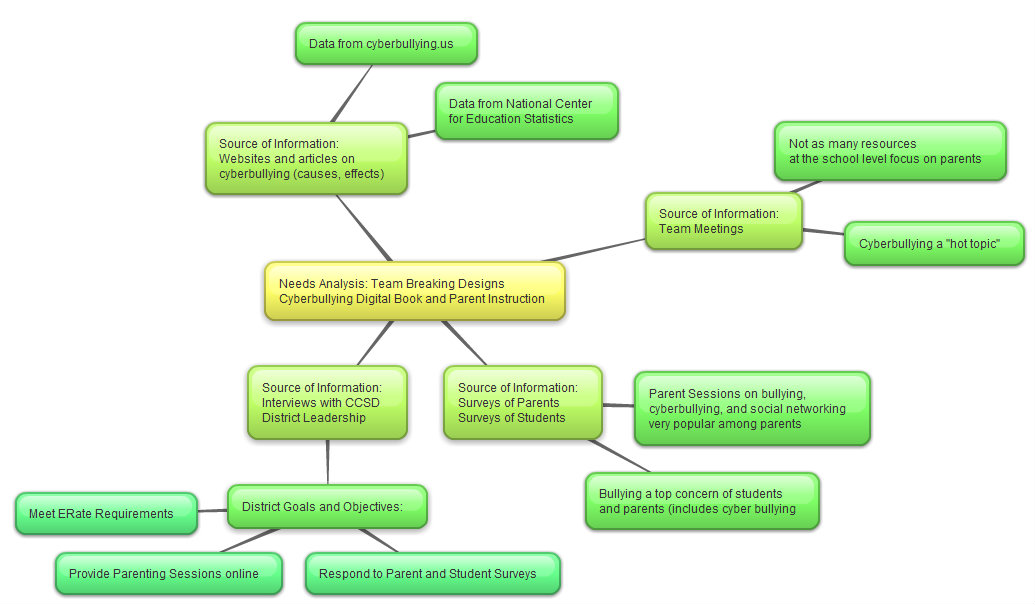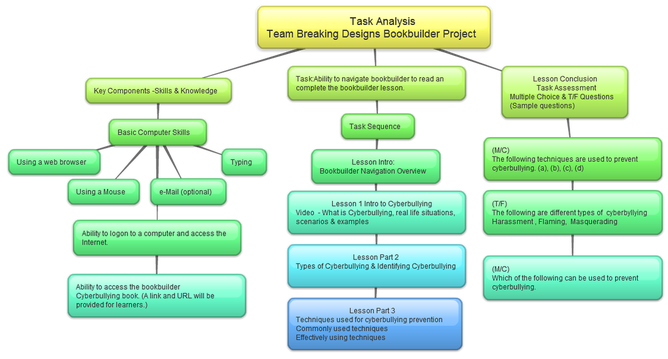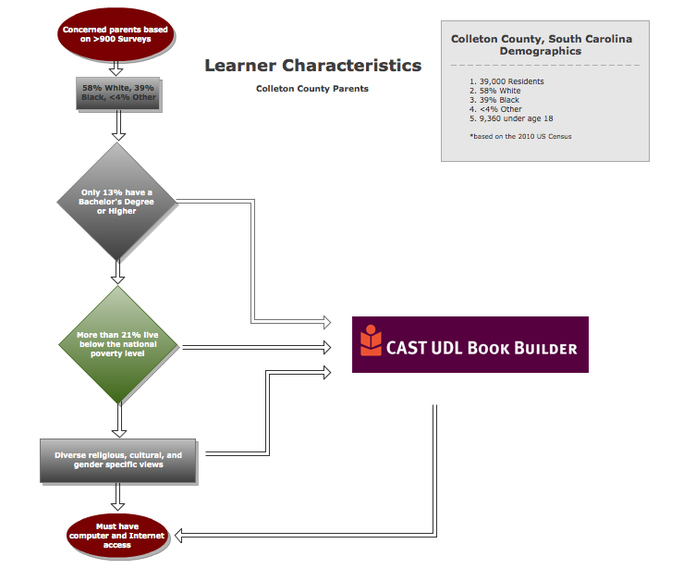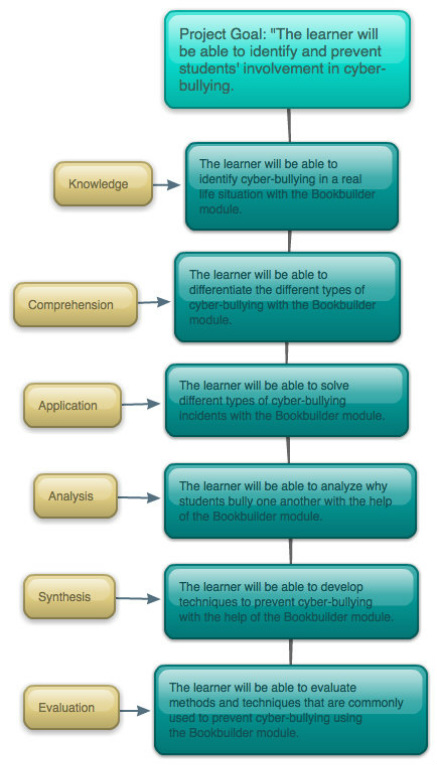Analysis
Objectives
1. Define need for the project and deliverables; identify learners, goals, and objectives.
2. Design and create an online session that provides parents resources to prevent bullying and protect students online
3. Design and create a digital book and cyberbullying lesson to meet the needs of the Colleton County School District’s Parent Involvement Program to increase the quantity and quality of online parenting sessions
4. Provide internet safety training that includes training for parents and students on internet safety and digital citizenship in order to meet instructional requirements and enable the district to continue to receive e-rate funding
2. Design and create an online session that provides parents resources to prevent bullying and protect students online
3. Design and create a digital book and cyberbullying lesson to meet the needs of the Colleton County School District’s Parent Involvement Program to increase the quantity and quality of online parenting sessions
4. Provide internet safety training that includes training for parents and students on internet safety and digital citizenship in order to meet instructional requirements and enable the district to continue to receive e-rate funding
Process used for this analysis
Because the Colleton County School District has provided access to survey and attendance data, team Breaking Designs has supplemented the provided data through interviews, research on the requested topic, as well as the standards and requirements of the related federal legislation and state curriculum standards.
Needs Analysis
According to conversations with the Colleton County School District Director of Federal Special Programs, Catherine Turner, and Assistant Superintendent Dr. William Dixon, the Colleton County School District had three main objectives in requesting the creation of an online lesson for parents on cyberbullying. First, an online session would meet the needs of parents and students who responded to school climate and parent involvement surveys with requests for the district to provide resources to prevent bullying and protect students online. Secondly, a professionally designed digital book and cyberbullying lesson would meet the needs of the district’s Parent Involvement Program to increase the number and improve the quality of online parenting sessions in order to serve more parents as well as the program’s mission to improve student achievement by increasing the knowledge and skills of parents. Finally, the Internet safety training provided through this project, which includes training for parents and students on Internet safety and digital citizenship, is a requirement for the district to continue to receive e-rate funding that helps pay for technological improvements and Internet access for the entire district.
Team Breaking Designs used the school district’s requests and surveys as the basis for the needs assessment and supplementing that information with statistics from the National Center for Education Statistics and the Cyberbullying Research Center for data about cyberbullying nationally. Bullying or cyberbullying may affect 20 – 30% of students and is likely under-reported in the Colleton County School district, so training parents and staff to be aware of the signs and symptoms is important for the wellness of all students.
The program that team Breaking Designs is developing will incorporate Common Core and South Carolina Internet Safety Standards as well as Universal Design for Learning in order to make the online lesson as accessible as possible. The team product will be a bookbuilder digital book that will be used as a primary component in the online lesson.
Because the school district and the resources listed have already completed extensive surveys of parents and students, Team Breaking Designs will not perform additional surveys or interviews for the needs analysis phase of the project.
Team Breaking Designs used the school district’s requests and surveys as the basis for the needs assessment and supplementing that information with statistics from the National Center for Education Statistics and the Cyberbullying Research Center for data about cyberbullying nationally. Bullying or cyberbullying may affect 20 – 30% of students and is likely under-reported in the Colleton County School district, so training parents and staff to be aware of the signs and symptoms is important for the wellness of all students.
The program that team Breaking Designs is developing will incorporate Common Core and South Carolina Internet Safety Standards as well as Universal Design for Learning in order to make the online lesson as accessible as possible. The team product will be a bookbuilder digital book that will be used as a primary component in the online lesson.
Because the school district and the resources listed have already completed extensive surveys of parents and students, Team Breaking Designs will not perform additional surveys or interviews for the needs analysis phase of the project.
Concept Map - Needs Analysis
| simmons-s-needs-analysis_14vkttuv.jpg | |
| File Size: | 128 kb |
| File Type: | jpg |
Content (Task) Analysis
Purpose:
The purpose of the task analysis is to lay out the foundation for the activities that will take place during the lesson. The task analysis includes identifying the knowledge and skills that are needed in order to successfully complete the lesson. It also outlines the order in which the tasks will be completed during the lesson. To ensure that the lesson has been successfully completed an end of lesson assessment will be incorporated.
Project Task Analysis:
Task analysis for our book builder project has allowed us to highlight the knowledge and skills needed to complete the lesson. The essential prerequisite skills identified for this lesson are basic computer skills such as using a mouse, typing, a web browser and the option of e-mail. The lesson participants also need to be able to logon to a computer, access the Internet and the Book Builder website. In developing the lesson for our Book Builder project we have included five major components for our lesson development. They are as follows:
1. Book Builder navigation overview
2. Introduction to cyberbullying
3. Types of cyberbullying & identification of cyberbullying
4. Techniques used for cyberbullying prevention
a. Commonly used techniques for prevention
b. How to effectively use prevention techniques
5. Lesson conclusion & assessment in designing and developing the lesson our content will support the components identified. The team will work collaboratively to develop and acquire lesson materials such as videos, slides, assessments to ensure the that the participants are able to successfully complete the lesson.
The purpose of the task analysis is to lay out the foundation for the activities that will take place during the lesson. The task analysis includes identifying the knowledge and skills that are needed in order to successfully complete the lesson. It also outlines the order in which the tasks will be completed during the lesson. To ensure that the lesson has been successfully completed an end of lesson assessment will be incorporated.
Project Task Analysis:
Task analysis for our book builder project has allowed us to highlight the knowledge and skills needed to complete the lesson. The essential prerequisite skills identified for this lesson are basic computer skills such as using a mouse, typing, a web browser and the option of e-mail. The lesson participants also need to be able to logon to a computer, access the Internet and the Book Builder website. In developing the lesson for our Book Builder project we have included five major components for our lesson development. They are as follows:
1. Book Builder navigation overview
2. Introduction to cyberbullying
3. Types of cyberbullying & identification of cyberbullying
4. Techniques used for cyberbullying prevention
a. Commonly used techniques for prevention
b. How to effectively use prevention techniques
5. Lesson conclusion & assessment in designing and developing the lesson our content will support the components identified. The team will work collaboratively to develop and acquire lesson materials such as videos, slides, assessments to ensure the that the participants are able to successfully complete the lesson.
Concept Map Task Analysis
| taskanalysis.png | |
| File Size: | 78 kb |
| File Type: | png |
Learner Analysis
According to the 2010 census conducted by the United States Census Bureau, Colleton County, South Carolina has a population of approximately 39,000 residents. The racial demographics are estimated at 58% white, 39% black, and less than 4% of hispanic, asian, or other descent. Approximately 24% of the population (9,360) are 18 years or younger and more specifically, fall within a school-aged demographic.
The creation of the Breaking Designs cyberbullying instructional material is intended to educate the parents of school-aged children in Colleton County, South Carolina on how to successfully handle situations pertaining to cyberbullying and their children. After the collection of over 900 surveys, parents in Colleton County have strongly indicated that they are genuinely concerned about bullying related to school interaction, specifically that which occurs on the internet. As the effects of bullying can have a life-long impact, parents who participate in this instruction are genuinely concerned about their children’s safety and emotional health and how it can be affected by online social interaction. These parents will gain access to information regarding protecting their children from cyberbullying, understanding signs that their child may be being harassed, monitoring their child’s online presence, asking the appropriate questions, and disciplining their child if he or she is engaging in harassing behavior.
Only an estimated 13% of the residents of Colleton County have a Bachelor’s Degree or higher education and more than 21% are estimated to be at or below the national poverty level. Thus, parents of Colleton County students are understood to have a wide range of educational backgrounds, language skills, and learning abilities. Breaking Designs will unveil a universal design approach which will be utilized during the development stage of the instructional application.
In addition to the educational and socio-economic considerations, the BookBuilder instruction will also take a cultural, religious, and gender neutral approach to all learning materials so as to not isolate or promote any demographic group. By carefully considering all of these learner characteristics, the intention will be to promote a higher level of connection to purpose for all parents who choose to participate.
The requirements needed in order to view the instructional lesson will be access to a computer and Internet. The BookBuilder platform works well with all common computer operating systems and Internet browsers. An instructional tutorial pamphlet will also be given to parents (email and hardcopy) listing the web URL and general directions detailing the easiest ways to access and begin the instruction. Lastly, a list of local public libraries and computer facilities will be provided for those parents who do not have computer access in their homes.
In order to provide timely feedback, a multiple-choice survey will be implemented once a parent has completed the BookBuilder instruction. The questionaire will provide Breaking Designs personelle with essential information regarding the effectiveness of the materials as well as any changes that would be beneficial to implement at a later date.
The creation of the Breaking Designs cyberbullying instructional material is intended to educate the parents of school-aged children in Colleton County, South Carolina on how to successfully handle situations pertaining to cyberbullying and their children. After the collection of over 900 surveys, parents in Colleton County have strongly indicated that they are genuinely concerned about bullying related to school interaction, specifically that which occurs on the internet. As the effects of bullying can have a life-long impact, parents who participate in this instruction are genuinely concerned about their children’s safety and emotional health and how it can be affected by online social interaction. These parents will gain access to information regarding protecting their children from cyberbullying, understanding signs that their child may be being harassed, monitoring their child’s online presence, asking the appropriate questions, and disciplining their child if he or she is engaging in harassing behavior.
Only an estimated 13% of the residents of Colleton County have a Bachelor’s Degree or higher education and more than 21% are estimated to be at or below the national poverty level. Thus, parents of Colleton County students are understood to have a wide range of educational backgrounds, language skills, and learning abilities. Breaking Designs will unveil a universal design approach which will be utilized during the development stage of the instructional application.
In addition to the educational and socio-economic considerations, the BookBuilder instruction will also take a cultural, religious, and gender neutral approach to all learning materials so as to not isolate or promote any demographic group. By carefully considering all of these learner characteristics, the intention will be to promote a higher level of connection to purpose for all parents who choose to participate.
The requirements needed in order to view the instructional lesson will be access to a computer and Internet. The BookBuilder platform works well with all common computer operating systems and Internet browsers. An instructional tutorial pamphlet will also be given to parents (email and hardcopy) listing the web URL and general directions detailing the easiest ways to access and begin the instruction. Lastly, a list of local public libraries and computer facilities will be provided for those parents who do not have computer access in their homes.
In order to provide timely feedback, a multiple-choice survey will be implemented once a parent has completed the BookBuilder instruction. The questionaire will provide Breaking Designs personelle with essential information regarding the effectiveness of the materials as well as any changes that would be beneficial to implement at a later date.
Concept Map - Learner Analysis
| winters_nathan_learner_characteristics.jpg | |
| File Size: | 132 kb |
| File Type: | jpg |
Context (Goal) Analysis
Intended Use: For parents to help end cyberbullying among students in Colleton County. Content will be accessed online at the parent's convenience.
Method: ABCD's of objectives and Bloom's Taxonomy
Relevant Information I Learned: I learned how to create a well stated goal and subordinate objectives. This helps me understand where we're going with the project and its intended outcome. I also learned that not every objective will have a clear degree of performance.
I've broken the project goal into the smaller objectives in the order of Bloom's Taxonomy. First, the learner should be able to effectively identify what constitutes as cyber-bullying. Once that's learned, the learner should be able to categorize or identify the different ways cyber-bullying can happen. The graphic below explains the rest of the project objectives, but to summarize, the learner must gain as much information as they can about cyber-bullying before learning how to do deal with it. Each learning step must be completed before moving onto the next one.
Project Goal: Parents will be able to identify and prevent students' involvement in cyberbullying.
Smaller Objectives: (red=Audience, blue=Behavior, green=Conditions, purple=Degree)
The learner will identify cyberbullying in a real life situation with the Bookbuilder module.
The learner will develop techniques to prevent cyber-bullying with the Bookbuilder module.
The learner will implement lessons to use to prevent cyber-bullying with the Bookbuilder module.
Describe your analysis of the context where your product is intended to be used. Include your methods as well as the relevant information you learned. Be sure to discuss any details regarding context that only became apparent when you tested your instruction later on in the project. (doing this later I believe when it's tested)
Method: ABCD's of objectives and Bloom's Taxonomy
Relevant Information I Learned: I learned how to create a well stated goal and subordinate objectives. This helps me understand where we're going with the project and its intended outcome. I also learned that not every objective will have a clear degree of performance.
I've broken the project goal into the smaller objectives in the order of Bloom's Taxonomy. First, the learner should be able to effectively identify what constitutes as cyber-bullying. Once that's learned, the learner should be able to categorize or identify the different ways cyber-bullying can happen. The graphic below explains the rest of the project objectives, but to summarize, the learner must gain as much information as they can about cyber-bullying before learning how to do deal with it. Each learning step must be completed before moving onto the next one.
Project Goal: Parents will be able to identify and prevent students' involvement in cyberbullying.
Smaller Objectives: (red=Audience, blue=Behavior, green=Conditions, purple=Degree)
The learner will identify cyberbullying in a real life situation with the Bookbuilder module.
The learner will develop techniques to prevent cyber-bullying with the Bookbuilder module.
The learner will implement lessons to use to prevent cyber-bullying with the Bookbuilder module.
Describe your analysis of the context where your product is intended to be used. Include your methods as well as the relevant information you learned. Be sure to discuss any details regarding context that only became apparent when you tested your instruction later on in the project. (doing this later I believe when it's tested)
Concept Map - Goal Analysis
| goalanalysis.jpg | |
| File Size: | 83 kb |
| File Type: | jpg |





